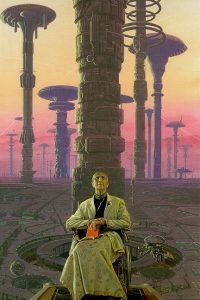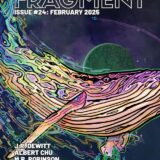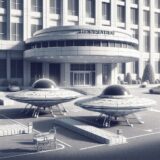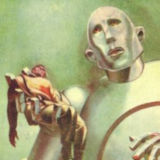The events in Boston at the beginning of this week were an awful tragedy and, naturally all our hearts go out to the victims. Boston is one of the oldest cities in the US and, like all cities, it has a character and a resilience just like people do. Thinking about the city of Boston this week has gotten me thinking about how we used to imagine the cities of the future.
Whether we pictured a shining utopia or a grungy dystopia, cities usually figure fairly prominently in science fiction stories and novels. Whether they are on a future earth, or another earth or floating out in space the futuristic urban environment is one of the great subjects that science fiction artists have fun depicting. One of the earliest science fiction illustrators, Frank R. Paul, excelled at depicting future machines. Paul was working from the age of radio and that technology influenced much of his design of futuristic cityscapes. Indeed much of his architecture resembled the inner workings of a 1920’s radio laid out and made large.
From this same era, comes Fritz Lang’s famous expressionistic silent film METROPOLIS. In it the future of the world is depicted as a giant city redolent with expressionistic design. Lang’s future is a sprawling city whose workings are powered by steam and the sweat of workers pushed to the brink of exhaustion.
 The city as a concept was pushed to its extremes by Isaac Asimov in his Foundation series where he introduces us to Trantor, the city that covers an entire planet. From Trantor, the heart of Asimov’s future galactic empire, Hari Seldon sees a vision of the future and the downfall of these marvelous edifices. Here is one of my favorite images of Trantor as painted by the amazingly talented Michael Whelan. Here he depicts Hari Seldon sitting in front of the sprawling city of Trantor, it’s massive towers almost reaching into the upper atmosphere. From his wheelchair he gazes solemnly into some future that only he can see.
The city as a concept was pushed to its extremes by Isaac Asimov in his Foundation series where he introduces us to Trantor, the city that covers an entire planet. From Trantor, the heart of Asimov’s future galactic empire, Hari Seldon sees a vision of the future and the downfall of these marvelous edifices. Here is one of my favorite images of Trantor as painted by the amazingly talented Michael Whelan. Here he depicts Hari Seldon sitting in front of the sprawling city of Trantor, it’s massive towers almost reaching into the upper atmosphere. From his wheelchair he gazes solemnly into some future that only he can see.
The concept of the city that encompasses a world was new and exciting when Asimov originally wrote the stories that would eventually make up the Foundation series, but the idea has since been co-opted by many science fiction writers, comic book artists and moviemakers. George Lucas swiped the concept for the planet of Coruscent in the Star Wars prequel movie, The Phantom Menace. The new Star Trek movies from J. J. Abrams also depict what appears to be gigantic structures, vaguely scene in the background of Iowa that hints at some mammoth urban development just over yonder from the wheat fields.
Dystopic cities are also favorite tropes of science fiction writers, particularly the grungy, broken down cityscapes depicted by authors such as William Gibson. In his novels of the future such as Neuromancer or Mona Lisa Overdrive, Gibson eschews the shining core of the cities, the heart of the business district, for the edges, the periphery, the places where construction projects have failed and the homeless and disenfranchised have repurposed it for their own uses.
My favorite depictions of future cities are the shining, wild and beautiful cityscapes like this one depicted by Donato Gincola. Here is a cityscape bathed in light and decorated with beautiful, art-deco inspired designs. This is a beautiful city where golden, science fiction dreams come true.
Of course, it probably costs you an arm and a leg to live there. Perhaps it does. Perhaps the woman wrapped in the white sheet has a robot body underneath — her flesh being the cost of living in this gleaming utopia.
That’s the power of imagining cities of the future in a science fiction context — despite all the gleaming lights and shining towers, there is always a cost to running and to living in these future utopias or dystopias, and the astute science fiction writer will usually figure that out and spin an entertaining tale in the process.
What about you? What’s your favorite science fiction utopia and/or dystopia? Leave a comment and let me know.














Recent Comments